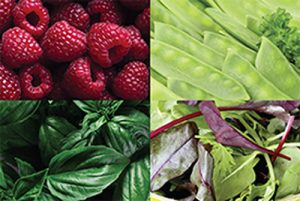Steven Musser Ph.D., Deputy Director for Scientific Operations, FDA’s Center for Food Safety and Applied Nutrition (CFSAN) and Alexandre da Silva, Ph.D., Lead Parasitologist at CFSAN’s Office of Applied Research and Safety Assessment, write that Cyclospora cayetanensis is so small that it can only be seen with a microscope. However, there is nothing small about the U.S. Food and Drug Administration’s work to help protect consumers from the foodborne illness that this parasite can cause.
 Of course it’s small. So are the trillion of microorganisms inside each of us.
Of course it’s small. So are the trillion of microorganisms inside each of us.
Cyclospora has been on the public radar since at least 1996.
Cyclosporiasis is an intestinal illness caused by consumption of foods, mainly fresh produce, that are contaminated with Cyclospora. The FDA has been working to help prevent contaminated product from reaching consumers, gathering the scientific knowledge that will help to better detect the parasite in food and the environment, and gathering data to better understand how food is contaminated by the parasite and help prevent contamination in the future. We’re also sharing what we know with stakeholders in the public and private sectors.
Because several past outbreaks have been associated with fresh herbs, the FDA has been conducting surveillance sampling of fresh cilantro, parsley and basil. A quarterly update on this food surveillance study was released today. As this effort continues, our goal is to collect enough samples to provide a precise estimate of the prevalence of contamination of Cyclospora in our food supply, enabling us to better understand our vulnerability to Cyclospora contamination.
The FDA is also acting on what we already know about where Cyclospora is found and how contamination can be prevented.
In 2019, 10% of the Cyclospora infections reported between May and August were linked to a multi-state outbreak associated with fresh imported basil that started in mid-June and was declared over in October. FDA increased its screening at the border of basil exported by the company tied to the outbreak before the company voluntarily recalled its product and ceased shipping while corrective measures were implemented.
The FDA is also tracking contamination in domestically-grown produce. The first confirmed evidence of Cyclospora in domestically grown produce was detected in 2018 in cilantro, a finding not associated with an outbreak of illnesses. As with bacterial pathogens, if the parasite is found on produce, the FDA follows up with inspections and sampling, working with the business to take the actions needed to protect public health.
 The FDA has been reaching out to farmers to increase awareness of Cyclospora and actions that can be taken on the farm to reduce the likelihood of contamination. For example, ways to control sources of contamination include proper use, maintenance and cleaning of toilet and handwashing facilities. We created education and outreach materials for farmers, including the Cyclosporiasis and Fresh Produce Fact Sheet.
The FDA has been reaching out to farmers to increase awareness of Cyclospora and actions that can be taken on the farm to reduce the likelihood of contamination. For example, ways to control sources of contamination include proper use, maintenance and cleaning of toilet and handwashing facilities. We created education and outreach materials for farmers, including the Cyclosporiasis and Fresh Produce Fact Sheet.
In late 2014, the FDA’s Center for Food Safety and Applied Nutrition established a Foodborne Parasitology Research Program, and in collaboration with the CDC, has been sequencing the genomes of several different strains of C. cayetanensis, enabling the development of genetic typing methods. In 2016, we created a genome database named “CycloTrakr” to be used as a public repository of genomic data at the National Center for Biotechnology Information (NCBI). This is an important first step towards the goal of linking, in real-time, the genetic fingerprints of Cyclospora in contaminated food and sick people to pinpoint the source of the outbreaks.
The agency has also pioneered ways to detect the parasite, developing and validating new methods to test for Cyclospora in produce and water. The first of these new methods was used for the first time in 2018 to confirm the presence of the parasite in a salad mix product tied to an outbreak that sickened hundreds of people.
In July 2019, the FDA made its second major advance in Cyclospora detection, completing studies that resulted in a novel, validated method to test agricultural water for the presence of the parasite. Water used on farms is a potential source of the contaminants that cause foodborne illnesses. Analysts from FDA laboratories are being trained in the use of this method for regulatory testing.
